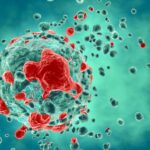October is Breast Cancer Awareness Month

Every year in October, in countries around the world, people splash pink across clothes, banners, buildings, and just about anything to bring awareness to the annual breast cancer health campaign. Breast cancer is the second most common cancer among women in the United States. Andy Ewald, a Physical Sciences-Oncology Center researcher at Johns Hopkins University is tackling the fight against breast cancer by studying metastasis—when cancer spreads from the primary tumor site to other parts of the body. By understanding how metastasis works, researchers may be able to identify preventative strategies to stop metastasis and improve patient outcomes, which is important since about 90% of cancer related deaths happen when cancer reaches the metastatic stage.
Below is a collection of some of Ewald’s work and his investigations on metastasis.
Breast Cancer Cells “Stick Together’ to Spread Through the Body During Metastasis
E-cadherin, a cell adhesion protein, allows cells to stick to each other, promoting metastasis in the most common type of breast cancer. Results suggest that breast cancer cells need adhesive connections to survive and eventually spread and kill patients. “Our future research aims to understand how to target the survival signals related to E-cadherin and prevent metastases from forming, thereby saving patients’ lives,” Ewald says.
Scientists Discover a Dynamic Cellular Defense Against Breast Cancer Invasion
Mouse tissue grown in the lab show that the cell layer surrounding breast milk ducts reaches out to grab stray cancer cells to keep them from spreading through the body. The findings reveal that this cell layer, called the myoepithelium, is not a stationary barrier to cancer invasion, as scientists previously thought, but an active defense against breast cancer metastasis
BCRF-Supported Study Identifies Novel Target in Metastasis
Andrew Ewald made a stunning discovery that may aid in our understanding of metastasis that may explains how cancer cells survive with the help of a protein called E-cadherin. Dr. Ewald describes how E-cadherin, which is known to suppress cancer cell invasion – the first step in metastasis – actually promotes the survival of cancer cells that do invade.
Taking Aim at Metastasis
Metastasis is a multi-step process. The cancer cells need to leave, travel through the adjacent tissue, survive traveling through the blood vessels, escape the immune system the whole time, and grow out in a new organ. We want to know what molecular tools they’re using to survive the journey through the body.
Latest Posts
-
 Q&A with PSON Intern Jocelyn Hsu
August 19, 2021
Q&A with PSON Intern Jocelyn Hsu
August 19, 2021
-
 Start Up Founders from Johns Hopkins Aim to Stop Spread of Cancer
August 3, 2021
Start Up Founders from Johns Hopkins Aim to Stop Spread of Cancer
August 3, 2021
-
 Protein Appears to Prevent Tumor Cells from Spreading Via Blood Vessels
July 15, 2021
Protein Appears to Prevent Tumor Cells from Spreading Via Blood Vessels
July 15, 2021


